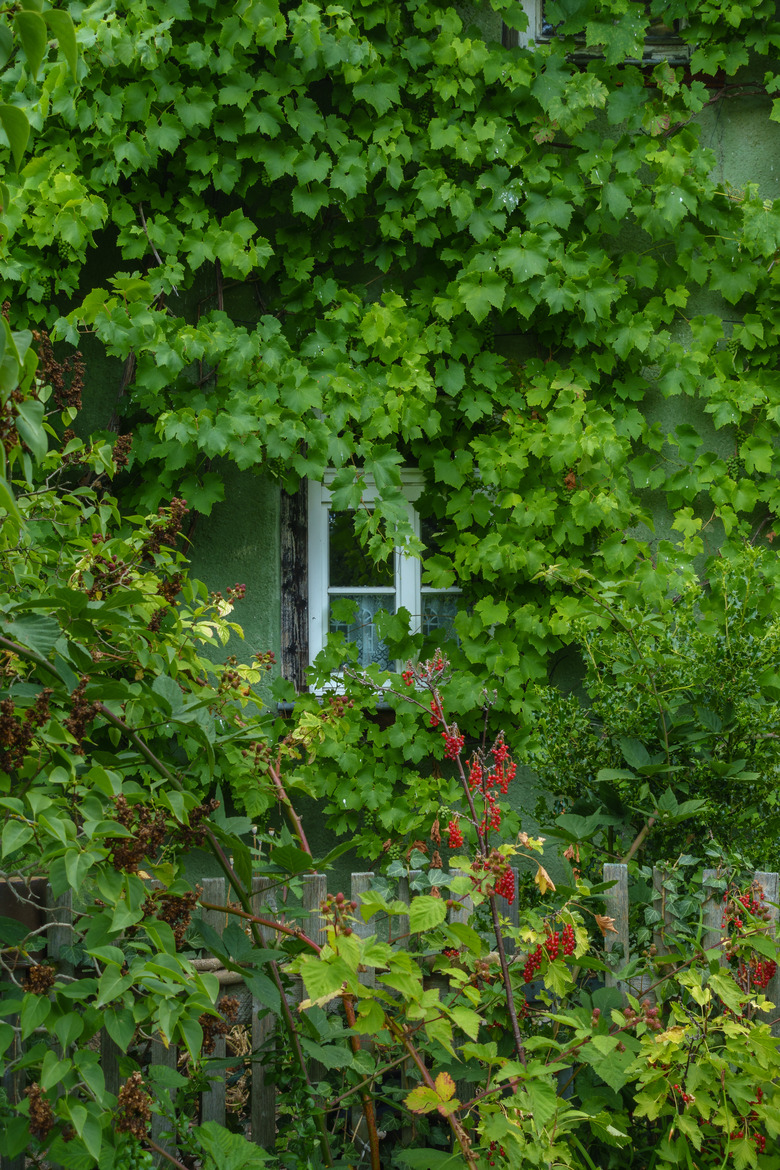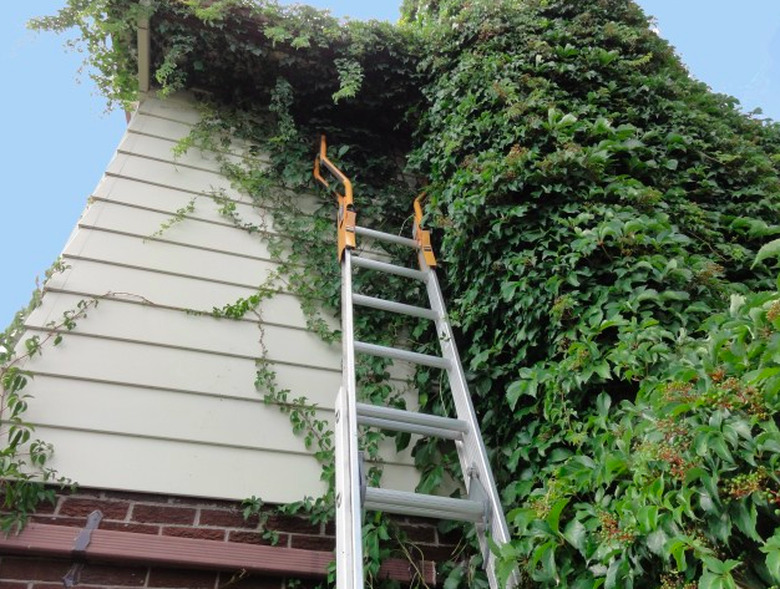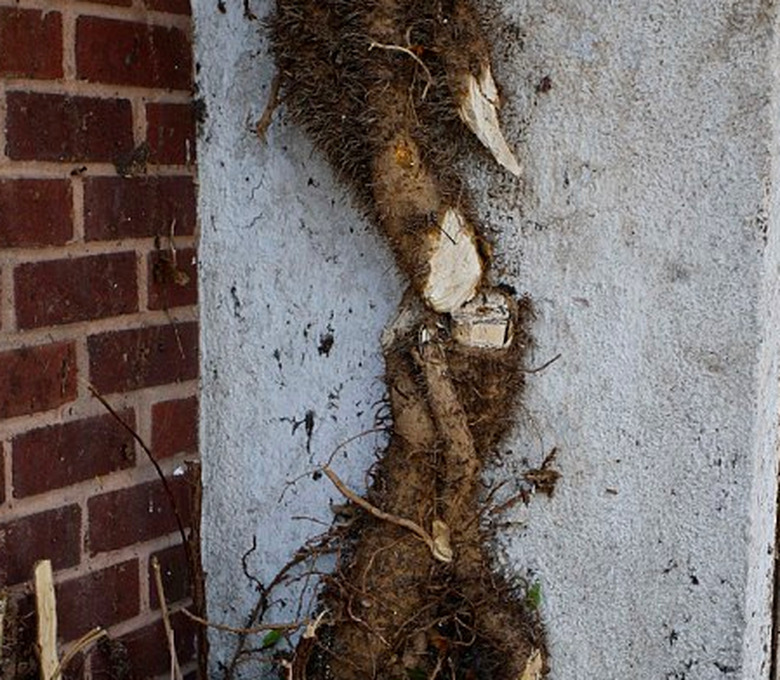How To Remove Vines From House Siding
Creeping vines clinging to the side of a home aren't always a problem. You've probably seen an old stone or brick house covered with ivy. On these houses, the ivy can actually be beneficial, especially if the side of the house on which they are growing gets plenty of sun. Vines protect the siding from sudden changes in temperature and humidity that cause cracking and spalling. Plus, they add charm. English ivy and Boston ivy—that favorite vegetative covering on ivy league schools—are evergreen plants. Another favorite, Virginia creeper, assumes an attractive red coloration in the fall.
Unfortunately, these vines are not harmless on a house with stucco or wood, vinyl, or fiber cement siding. Here, vines hold moisture against the wall, promoting siding deterioration, and they can even work their way through gaps in the window trim and grow into the home. Vines can also grow between siding planks, forcing them apart and allowing moisture to penetrate behind the siding. If there is damage, you might not know before it's too late, because a thick growth of ivy prevents you from evaluating the condition of your siding.
If vines are growing on your house, you should prune them back yearly to prevent runaway growth. Once things have gotten out of hand, though, you may have to remove the vines entirely. Get ready for some hard work, because the stickers are surprisingly strong, and there's no better way to do the job than to physically pull them off.
Preparing for a Big Job
Preparing for a Big Job
Before you start the job of cutting and removing the vines, you should assemble the tools you need. These include a hedge trimmer, a set of sharp pruners and some long-handled lopping shears for cutting the plants near the roots. You'll also need a ladder, which should have a stabilizer that anchors it securely to the wall, because you'll be moving quite a bit while you're on it. Don't forget the tools and supplies you need to clean up the siding after the vines are gone, including a bucket, a hard-bristle scrub brush, some trisodium phosphate (TSP), a sponge and a palm sander with 120-grit paper.
You may also want to kill the plants at the roots to prevent them from growing again. You can use a commercial herbicide, but if you choose a glyphosate-based product such as Round-Up, it's best to wait for spring. Plants have to absorb this product through the leaves, and it works best when the leaves are new and growing quickly.
Tip
If you're squeamish about using herbicides, you're not alone. Round-Up and other weed killers can kill other plants in your garden if you're not very careful in the application, and there is the chance they can make it into groundwater supplies. There are less troublesome ways to kill vines—you can kill them with table salt, for example, using a procedure that won't affect any other vegetation.
Sever the Plants and Kill the Roots
Sever the Plants and Kill the Roots
You may have to trim some growth back so you can see what you're doing, especially near the roots. Use a hedge trimmer and your pruners to do that. Once you identify the main stalk of each vine, cut out a 2-foot section with the loppers. It's a good idea to wait for one of two weeks for the vines to wilt above the cut area before trying to remove them. They'll offer less resistance and your job will be easier. However, you should treat the roots immediately while the sap is still circulating.
A simple way to kill the roots is to make a clean cut on the end of each one, then wrap duct tape around the ends to form a 2-inch deep cup. Fill the cup with table salt, then pour in about 1 ounce of water and cover the cup with another piece of tape. The roots will absorb the salty water and should die in a few weeks or months. You can then cut them back to ground level.
Remove the Vines
Remove the Vines
Removing the vines clinging to the side of the house can be a very difficult task. It's best to start pulling the vines from the top of the house and work your way down. You'll encounter less resistance from the smaller upper growth, and you might get lucky and remove an entire runner in one pull. Don't pull too hard, though. If the vine has grown under a siding board or behind a trim board, it's possible to pull off the board along with the runner.
In most cases, it's best to cut runners into pieces, using pruners, and pull off the pieces one by one. In corners and around windows where several runners often overlap, you may have to remove them in layers, cutting in several places to disengage the runners from each other before pulling them off.
If you've let the vine wilt, most of it should come off as you pull, but there will inevitably be sap discoloration on the siding left after the vine is gone. You may be able to clean most of this off by scrubbing with a solution of TSP and water. Be sure to wear gloves if you do this, because TSP is caustic. If you can't remove the discoloration by scrubbing, you may have to sand it off. If so, you'll probably have to prime and paint the siding after the vine removal is complete.
If You Like Ivy, Build a Trellis
If You Like Ivy, Build a Trellis
Once you remove the vines growing on your house, you're bound to have a better appreciation for the damage they can do. However, if you like the look of the vines, and you appreciate the extra insulation they provide in hot and cold weather, there's a way to have your cake and eat it, too. Instead of killing the roots, build a wooden or wire mesh trellis on the side of the house about 4 to 8 inches away from the siding. Let the vines grow back, but train them to creep up the trellis instead of the siding.
If you're ready for a change, you don't have to let your old vines grow back. If you killed them using the salt method, you haven't damaged the soil and you can plant whatever you want. Besides ivy, several vine species are good candidates for house cover, including pipevine, clematis and trumpet creeper. Choose according to your climate zone and the amount of rainfall you receive.



